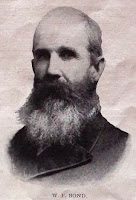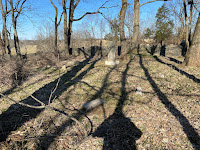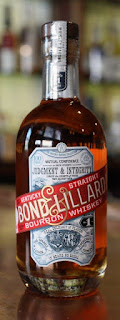 During the 53 years from 1812 until 1865, the United States was embroiled in three wars, one against a colonial power, one against a neighbor, and one internecine. Members of an extended distilling family are counted as having participated in all three, a distinguishing element in the story of Bond & Lilliard, distillers of Anderson County, Kentucky. William F. Bond, shown here, anchored the family.
During the 53 years from 1812 until 1865, the United States was embroiled in three wars, one against a colonial power, one against a neighbor, and one internecine. Members of an extended distilling family are counted as having participated in all three, a distinguishing element in the story of Bond & Lilliard, distillers of Anderson County, Kentucky. William F. Bond, shown here, anchored the family.
William’s father was John Bond born in Anderson County, Kentucky, in August 1791, the son of pioneers William and Sarah Cranston Bond. Some writers erroneously have called him a veteran of the Revolutionary War, an impossibility since John was born eight years after that war ended. John would have been 21 at the time of the War of 1812, however, and a large contingent of Kentucky riflemen fought along side Kentuckian Andrew Jackson at the Battle of New Orleans. Although no direct evidence exists, John Bond may have been among them.
William Bond’s participation in the Mexican War is indisputable. He was a member of Company C of the Second Kentucky Volunteers, a regiment known as “The Salt River Tigers.” The name came from the 150 mile long river that flows through Kentucky. The Tigers are reported to have averaged about six feet with 42 men above that height. Henry Clay was a colonel with the regiment.
Some accounts have credited the Salt River Tigers with having turned the fate of battle at Buena Vista. The Mexican and American forces for some time had been facing each other behind the breastworks with only a few yards separating them. One senior officer suggested to another that a charge would be in order. “Instantly the tallest and fiercest of the Tigers, seeming to think a charge had been agreed upon, gave their particular yell for advance, and the enemy was repulsed.” The Tigers lost an estimated six men in the assault, shown above. William Bond emerged unscathed.
 William returned to Anderson County. John had built his first distillery in 1820 on a site that was not far from the McBrayer plant on Cedar Brook. [See McBrayer post of Oct. 2, 2011.] In 1836, needing more space, the distillery was moved to a site closer to Lawrenceburg. Six years later the “Founding Father” died and was buried in a cemetery located on a family-owned farm.
William returned to Anderson County. John had built his first distillery in 1820 on a site that was not far from the McBrayer plant on Cedar Brook. [See McBrayer post of Oct. 2, 2011.] In 1836, needing more space, the distillery was moved to a site closer to Lawrenceburg. Six years later the “Founding Father” died and was buried in a cemetery located on a family-owned farm.
John and his wife, the former Sarah Utterback, had several children, among them William born in 1826. When Sarah died, he remarried a woman named Mary Johnson and began a second family. This may explain why the distillery was left to the youngest child, David, who was still only an infant. Among Kentucky distillers this sometimes done to insure an income for the widow as custodian. By 1849 William, returned from the war, officially took over the operation. He was 23. The following year William married Sarah Mary Hanks. The couple would go on to have 12 children over the next 19 years.
 Meanwhile, William’s younger sister, Margaret had married Christopher C. Lilliard. Born in 1833, Lilliard, shown here in maturity, enlisted in the Confederate Army in July 1861. He was mustered in as a first Lieutenant in Company I of the Kentucky Second infantry, the same outfit as William Bond’s that had acquitted itself so valiantly in the Mexican War.
Meanwhile, William’s younger sister, Margaret had married Christopher C. Lilliard. Born in 1833, Lilliard, shown here in maturity, enlisted in the Confederate Army in July 1861. He was mustered in as a first Lieutenant in Company I of the Kentucky Second infantry, the same outfit as William Bond’s that had acquitted itself so valiantly in the Mexican War.
An early engagement of the regiment was at Fort Donelson, the battle shown above. This time the 2nd Kentucky did not fare so well. After a stunning victory for Northern forces led by General Grant, the entire regiment of more than eight hundred men was captured. Among them was Lieutenant Lilliard. After spending some time in Yankee prison camps, the Kentucky soldiers were exchanged and returned to fought on at Shiloh and other battles, taking many casualties. Sometime after his release Lilliard resigned his commission and went home.
 William Bond quickly realizes that his brother-in-law, also from a whiskey-making family, would make an excellent junior partner. Thus was born the distilling house of Bond & Lilliard. Their distillery was described as “located off Bond’s Mill Road about two miles from Sweet Mash.” The partners rapidly earned a reputation for making a high quality bourbon. Their whiskey would go on to win the Grand Prize at the Louisiana Purchase Exposition in St. Louis. The award gave the Bond & Lilliard brand tremendous credibility. Both partners became prosperous as a result. Bond was able to lodge his large family and attending servants in the mansion home shown below.
William Bond quickly realizes that his brother-in-law, also from a whiskey-making family, would make an excellent junior partner. Thus was born the distilling house of Bond & Lilliard. Their distillery was described as “located off Bond’s Mill Road about two miles from Sweet Mash.” The partners rapidly earned a reputation for making a high quality bourbon. Their whiskey would go on to win the Grand Prize at the Louisiana Purchase Exposition in St. Louis. The award gave the Bond & Lilliard brand tremendous credibility. Both partners became prosperous as a result. Bond was able to lodge his large family and attending servants in the mansion home shown below.
In June 1892, the distillery was destroyed by fire, a loss set at $10,000, but uninsured. The partners quickly built back. According to insurance underwriter records, the revived distillery, shown here, was of iron-clad construction with three warehouses of which two were ironclad with a metal or slate roof. The third warehouse was frame but had a fire resistant roof. Two of the warehouse were fully under “Bottled in Bond Act” government supervision, one was partially “free.”
 Things began to change in the 1890s. In 1894 Lilliard had a stroke that left him partially paralyzed. He gradually weakened over the next two years until June 1896 and died on the 24th at age 68. The Lexington Morning Herald obituary saluted him as “one of Lawrenceburg’s most prominent citizens and his death will cause sorrow in many other parts of the state.” He was buried in Lawrenceburg Cemetery adjacent to the monument shown here.
Things began to change in the 1890s. In 1894 Lilliard had a stroke that left him partially paralyzed. He gradually weakened over the next two years until June 1896 and died on the 24th at age 68. The Lexington Morning Herald obituary saluted him as “one of Lawrenceburg’s most prominent citizens and his death will cause sorrow in many other parts of the state.” He was buried in Lawrenceburg Cemetery adjacent to the monument shown here.
Lilliard’s death may have resulted in a change of name. Shown there is a J. Bond & Co.trademark drawing that may relate to the Bond family distilling interests. I am fascinated by the Nancy Hank’s name — Lincoln’s mother. William Bond’s wife was a “Hanks.” In this case, however, the name seems to relate to a sulky race horse that in 1892 broke the world record for the mile.
After Lilliard’s death William Bond seemed to have lost interest in running the distillery. By now in his seventies he may have been feeling the effects of age. In 1899, he sold the distillery and the brand name to the Whiskey Trust, an aggressive attempt by New York financiers at a whiskey monopoly. Bond lived another eleven years, dying in July 1910 from what was described as “a complication of diseases” at the age of 83.
 William’s obituary in the Lawrenceburg daily accounted him one of Anderson County’s oldest and richest citizens. It recounted his war record, his 1871-1872 service in the Kentucky legislature representing Anderson County, and his success as a distiller. The article concluded: “His benevolence of character made him one of the most popular citizens of this county, and his loss will be deplored by all who appreciate eminent worth and excellence of character.” After funeral services in his home William Bond was buried in Lawrenceburg Cemetery. His monument is seen here.
William’s obituary in the Lawrenceburg daily accounted him one of Anderson County’s oldest and richest citizens. It recounted his war record, his 1871-1872 service in the Kentucky legislature representing Anderson County, and his success as a distiller. The article concluded: “His benevolence of character made him one of the most popular citizens of this county, and his loss will be deplored by all who appreciate eminent worth and excellence of character.” After funeral services in his home William Bond was buried in Lawrenceburg Cemetery. His monument is seen here.
 Given the stellar reputation of Bond & Lilliard whiskey, Trust officials retained the name, turning over distillery operations to Stoll & Company, a Lexington-based firm that worked closely with the cartel . The Stolls on their letterheads and advertising claimed to be “sole proprietors of Bond & Lilliard.” [See post on the Stolls, April 23, 2017.] The bottle shown here likely dates from that era.
Given the stellar reputation of Bond & Lilliard whiskey, Trust officials retained the name, turning over distillery operations to Stoll & Company, a Lexington-based firm that worked closely with the cartel . The Stolls on their letterheads and advertising claimed to be “sole proprietors of Bond & Lilliard.” [See post on the Stolls, April 23, 2017.] The bottle shown here likely dates from that era.
 The coming of National Prohibition caused the disappearance of the brand for a number of years but was revived by the owners of Wild Turkey who continue to distill and bottle it at their facility in Lawrenceburg. While the original Bond & Lilliard recipe may be lost, at Wild Turkey an attempt apparently has been made to mimic what impressed the judges at the 1904 Louisiana Purchase Exposition by putting the 100 proof whiskey through a charcoal filtration to give it a lighter color and taste. The Bond & Lilliard bottle has been given a very distinctive label. It touts the whiskey as being “linked to the hearts of these two sturdy men.”
The coming of National Prohibition caused the disappearance of the brand for a number of years but was revived by the owners of Wild Turkey who continue to distill and bottle it at their facility in Lawrenceburg. While the original Bond & Lilliard recipe may be lost, at Wild Turkey an attempt apparently has been made to mimic what impressed the judges at the 1904 Louisiana Purchase Exposition by putting the 100 proof whiskey through a charcoal filtration to give it a lighter color and taste. The Bond & Lilliard bottle has been given a very distinctive label. It touts the whiskey as being “linked to the hearts of these two sturdy men.”
 In a 1906 supplement to Lawenceburg’s newspaper, the Anderson News, the unidentified author waxes poetic about the still thriving Bond & Lilliard distillery located in a lush natural environment: “As the traveler winds his way around [the lake stocked with fish and minnows] that leads to this plant, he is greeted by nature’s own sweet breath, spiked with mint, and the pungent and invigorating aroma of Bond & Lilliard grown ripe and mellow.” A contemporary photo of the site shows the surroundings still lush but of the distillery William Bond and Christopher Lilliard created, only a single wall remains.
In a 1906 supplement to Lawenceburg’s newspaper, the Anderson News, the unidentified author waxes poetic about the still thriving Bond & Lilliard distillery located in a lush natural environment: “As the traveler winds his way around [the lake stocked with fish and minnows] that leads to this plant, he is greeted by nature’s own sweet breath, spiked with mint, and the pungent and invigorating aroma of Bond & Lilliard grown ripe and mellow.” A contemporary photo of the site shows the surroundings still lush but of the distillery William Bond and Christopher Lilliard created, only a single wall remains.
Notes: This post, including photos, has been gathered from a number of sources available on the Internet. Of particular help were obituaries of the principals from Lawrenceburg newspapers.





Jack, please contact me at jcw0623@hotmail.com. There are numerous errors contained in this blog posting (through no fault of your own) due to completely inaccurate information that has been posted on the internet. I am a Bond family member (direct descendant of John Bond) who grew up roaming our Bond family lands in Lawrenceburg, and I can clear up most of the issues here based on our own family records and research.
ReplyDeleteMr. Bond: I very much appreciate your being in touch. My own sense of the story has been that there is confusion in the details online and I am delighted to better validate the contents. Will email you forthwith.
Delete